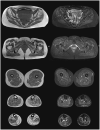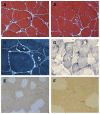First Family of MATR3-Related Distal Myopathy From Italy: The Role of Muscle Biopsy in the Diagnosis and Characterization of a Still Poorly Understood Disease
- PMID: 34659085
- PMCID: PMC8517147
- DOI: 10.3389/fneur.2021.715386
First Family of MATR3-Related Distal Myopathy From Italy: The Role of Muscle Biopsy in the Diagnosis and Characterization of a Still Poorly Understood Disease
Abstract
Mutations in the MATR3 gene are associated to distal myopathy with vocal cord and pharyngeal weakness (VCPDM), as well as familiar and sporadic motor neuron disease. To date, 12 VCPDM families from the United States, Germany, Japan, Bulgary, and France have been described in the literature. Here we report an Italian family with a propositus of a 40-year-old woman presenting progressive bilateral foot drop, rhinolalia, and distal muscular atrophy, without clinical signs of motor neuron affection. Her father, deceased some years before, presented a similar distal myopathy phenotype, while her 20-year-old son is asymptomatic. Myopathic changes with vacuolization were observed in muscle biopsy from the propositus. These results, together with the peculiar clinical picture, lead to MATR3 gene sequencing, which revealed a heterozygous p.S85C mutation in the propositus. The same mutation was found in her son. Over a 5-year follow-up, progression is mild in the propositus, while her son remains asymptomatic. Clinical, radiological, and pathological data of our propositus are presented and compared to previously reported cases of VCPDM. VCPDM turns out to be a quite homogenous phenotype of late-onset myopathy associated to p.S85C mutation in MATR3 gene. MATR3-related pathology, encompassing myopathy and motor neuron disease, represents an illustrative example of multisystem proteinopathy (MSP), such as other diseases associated to mutations in VCP, HNRNPA2B1, HNRNPA1, and SQSTM1 genes. The present report contributes to a further characterization of this still poorly understood pathology and points out the diagnostic utility of muscle biopsy in challenging cases.
Keywords: MATR3; distal myopathy with vocal cord paralysis; motor neuron; multisystem proteinopathy; muscular biopsy.
Copyright © 2021 Cavalli, Cardani, Renna, Toffetti, Villa and Meola.
Conflict of interest statement
The authors declare that the research was conducted in the absence of any commercial or financial relationships that could be construed as a potential conflict of interest.
Figures



References
-
- Senderek J, Garvey SM, Krieger M, Guergueltcheva V, Urtizberea A, Roos A, et al. . Autosomal-dominant distal myopathy associated with a recurrent missense mutation in the gene encoding the nuclear matrix protein, matrin 3. Am J Hum Genet. (2009) 84:511–8. 10.1016/j.ajhg.2009.03.006 - DOI - PMC - PubMed
LinkOut - more resources
Full Text Sources
Research Materials
Miscellaneous

